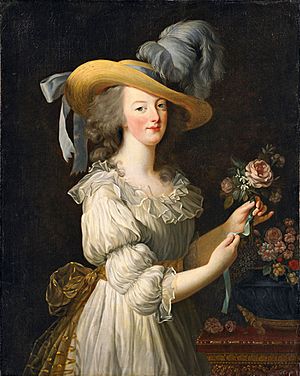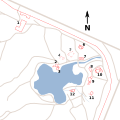Hameau de la Reine (Versailles) facts for kids

The Hameau de la Reine (which means "The Queen's Hamlet" in English) is a special village built in the huge park of the Palace of Versailles in France. It was created in 1783 for Queen Marie Antoinette. She wanted a place to pretend she was a simple country girl. She would wear a straw hat and plain dresses with her friends.
The hamlet has about twelve buildings. Some were real farm buildings. Others were just for the Queen's fun, like a mill. After the French Revolution, the hamlet was left alone and became run down. But in the 1990s, it was fixed up. Now, you can visit the Queen's Hamlet!
Contents
Building the Queen's Hamlet
Why the Hamlet Was Built
In the 1700s, it was popular for rich people in France to have small, fake villages. These villages were inspired by new ideas about nature. People wanted to enjoy a simpler, country life.
Queen Marie Antoinette loved this idea. She wanted her own special place at Versailles. So, she asked her favorite architect, Richard Mique, and a painter, Hubert Robert, to design it.
How the Hamlet Looked
The builders made the new buildings look old and humble. They even painted fake cracks and old wood on the walls. This made the hamlet seem like a real, old country village.
The buildings were designed to look like real farmhouses. They were inspired by styles from Normandy and Flanders. Building the hamlet started in 1783. It took about four or five years to finish.
Buildings in the Queen's Hamlet
The main goal of the hamlet was to give the Queen a quiet place. She could escape the busy life at the French court. The hamlet is built near a lake. This lake was made by bringing water from a place called Marly.
The buildings are split into two groups. One group was for the Queen's fun. The other group was for real farm work. The farm made milk and eggs for the Queen. They even made cheese in the dairy. The Queen would taste these fresh foods in a special marble room.
Here are some of the buildings:
- The Queen's House: This was connected to a billiard room. It also had an upstairs apartment. The first floor had a dining room and a games room. The second floor had living rooms and a Chinese room.
- The Queen's Boudoir: This was a private living room and dressing room for the Queen.
- The Marlborough Tower: Also called The Fishery Tower. It was like a small lighthouse. It was used to send signals to the Palace of Versailles. People also started boat trips from here. Fishing tools were kept inside.
- The Mill: This building was used to grind grain. It also had a laundry room.
- The Kitchen and Bakery: This was behind the Queen's House. It was used to cook meals for the Queen.
- The Dairies: These were where milk was processed and cheese was made.
- The Farmhouse: This was a real working farm. It was a bit separate from the other buildings. A farmer named Valy Bussard ran the farm and dairy. He moved there with his family in 1785.
- The Dovecote: This building was for pigeons. It was near the lake. Different kinds of chickens and roosters were brought here in 1785.
- The Housekeeper's Cottage: This house was right by the water. The first person to live there was Jean Bersy, a Swiss man, and his family.
- The Barn: This building was used as a ball room for dances. It was destroyed during the French Revolution.
- The Temple of Love: A small, pretty temple.
- The Belvedere: A small building with nice views.
Life in the Hamlet
Queen Marie Antoinette really enjoyed the simple life at the hamlet. It was a nice change from the strict rules of the court. She would pretend to be a peasant girl. She wore simple muslin dresses and a straw hat. She ate fresh food from the farm.
Only her closest friends were allowed to visit the hamlet. There was a special room for dances and a billiards room. The Queen also wanted her children to see real farm animals. She kept two cows, Blondie and Brownie. They were always washed and brushed before the Queen visited. Ducks, geese, sheep, and even a goat from Switzerland also lived at the hamlet.
What Happened Next
Many French people thought the Queen was being selfish. They felt she was having fun while France was facing big problems. After the French Revolution, the hamlet was left empty. It became very run down.
But in the 1990s, the Queen's Hamlet was fixed up and restored. Now, it is open to everyone to visit.
Images for kids













